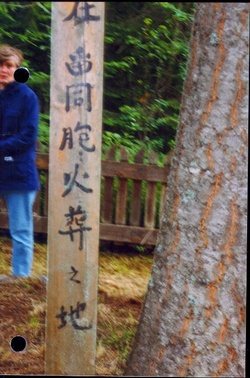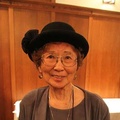There’s only one obvious sign today that Slocan, British Columbia was an internment camp for Japanese Canadians during the Second World War.

“Fellow countrymen—Cremated here”
Courtesy of West Kootenay Family Historians.
At the back of the village cemetery, a picket fence surrounds a rock slab with two trees growing out of it and a wooden pillar between them with Japanese inscriptions on all four sides. The origin and meaning of this monument has been the source of considerable speculation and puzzlement. Who put it there and when? Is it actually a burial site?
Some answers appeared thanks to Simon Fraser University, which digitized The New Canadian, a Japanese Canadian newspaper. According to the September 2, 1944 edition:
“Plans have been made by the Slocan Buddhist Mission Society to erect a memorial monument in commemoration of the deceased who were cremated at the Slocan cemetery before the New Denver crematorium was completed. Permission has been granted to erect this monument and work is expected to begin in the near future.”
There were no further mentions of the monument in the newspaper, at least through the end of the year, nor was it referred to in the Slocan city council minutes. (Perhaps permission came from the BC Security Commission, which was in charge of the internment camps.)
The Slocan Buddhist congregation was led by Rev. Kenryu Tsuji (1919–2004), who went on to become a bishop in San Francisco.
A check of death registrations reveals at least nine people—six men, one woman, one child, and an infant—were cremated in Slocan before a crematorium was established at nearby New Denver in April 1943. There were some sad cases among them.
- Takeo Kinoshita, 9, drowned in Slocan Lake on the evening of July 21, 1942, while swimming with a number of other children. He had only come to Slocan from Vancouver with his family seven weeks earlier. Funeral services were conducted over two days. According to the Nelson Daily News, “Cremation of the body was probably the first conducted at the Slocan centre, and permission for it was granted from Victoria.”
- Genjaemon Iguchi, 74, died October 30, 1942.
- Sadaroku Nakamura, 53, a fisherman, died November 6, 1942, of cancer.
- Suyeno Goto, 57, a housewife, died November 23, 1942, after refusing food.
- Haramatsu Fujita, 73, died November 27, 1942.
- Takejiro Toyota, 83, a farmer, died December 2, 1942, of a hemorrhage.
- Tomehiko Tateishi, 65, a labourer, died December 24, 1942, of cancer.
- Sheiguko Takayama, infant, died January 15, 1943, of pneumonia.
- Manmosuke Fukumoto, 55, died January 21, 1943, of cancer.
Two other people who died at Slocan may have also been cremated there, but their death registrations didn’t specify the location.
- Kireto Kimiko, 14, died January 6, 1943, although the cause is illegible.
- Misako Inouye, a year-old infant, died April 16, 1943, of acidosis.
I couldn’t find obituaries for any of these people in The New Canadian, partly because the newspaper stopped publishing around July 1942 in the upheaval of the internment. The first few editions when it resumed publishing that November are missing from the microfilm reel.
As for the monument itself, Roger Thickett relates how the Village of Slocan hired him in 1986 to supervise a crew of workers on a grant on various beautification projects, including rebuilding the ball park and renovating the area around the tennis court and curling rink.
One day they heard that a number of former internees were coming to Slocan and then-mayor Bernie Czelenski asked him to take the crew over to the cemetery and fix up the Japanese memorial.
“It was in very bad shape,” Thickett recalls. “The fence was derelict and the stone cairn was half collapsed. The post in the middle was black with age.”
In his childhood it was rumoured the cairn contained cremains or marked the site of burials, but he thought this unlikely (and indeed, it is). His crew took down the old wire fence, which had been reduced to a pile of rubble, and built the wooden picket fence that is there now. Thickett says the old wooden post was given to Bob Barkley, then a village councillor, who planed it to remove all the discoloured wood.
Barkley, however, says the post was actually replaced entirely—he’s not sure what happened to the original, but the replica had the same dimensions. Village staff dressed it on all four sides and local resident Fusako Yamamoto painted the Japanese characters—although no one’s quite sure if she was able to make out the old inscription or created a new one.
All four sides were still readable when the West Kootenay Family Historians visited in 1998 and had them translated as follows.
North side: “Fellow countrymen—Cremated here”
South side: “Rebuilt—Slocan—Donated”
East side: “May 1969”
West side: “Buddha have mercy on me”
The latter is a Buddhist prayer for the dead, but should 1969 actually read 1986? Or was the original marker rebuilt in 1969, and if so, by whom?
Mrs. Yamamoto’s daughter, Marion Arai, who lives in Vancouver, responded to a request I placed in The Bulletin, a Japanese Canadian journal.
She wasn’t aware of her mother’s involvement in the refurbished monument but confirms she was “known for her excellent calligraphy” and printed inscriptions on wooden gravemarkers. Mrs. Yamamoto herself died in June 2000 at 92.
Arai was able to shed further light on the cremations at Slocan.
“There was an organization of men called Hakko-kai who were to help other Japanese families sent to the Slocan Valley. My father, Takeshi, was very involved,” she wrote.
“When a person died in Slocan, a group of men was chosen to cremate the body. The site of the cremation was on the road to the mine—a long walk from Slocan and midpoint from Bay Farm. At these cremations, Rev. Tamura was the Buddhist priest present. My father talked of taking certain bones and delivering them to families who requested them.”
That road to the mine, I am guessing, is today’s Springer Creek Road.
Arai’s memory very closely matches passages in Joy Kogawa’s acclaimed novel Obasan, which is set in Slocan, where the author spent part of her childhood.
“Stephen whispers to me that the man who is going to take Grandma’s body up the mountain is called Mr. Draper … Later in the evening, Obasan, Stephen and I walk down the highway and up the steep road to the old silver mine … At first it was arranged to send the body to Spokane, but some carpenters told Obasan they would build a pyre and take turns keeping the fire going throughout the night at the old silver mine … The sun has been long gone … by the time we come to the end of the trail to the mine. There is a bunk house hidden in the trees where several families live. Farther up behind the rubble, where part of the mine used to be, is a clearing where the men are…”
While James Draper was real—among other things, he was New Denver representative for the E.W. Somers funeral home of Nelson, which built the crematorium—Kogawa says this part of the book was fiction.
The Village of Slocan has long been interested in restoring the overgrown site and adding interpretive signs to the memorial, but wanted to know more about it first to respect cultural sensitivities.
* This article was originally published in the Nelson Star on February 3, 2014, and has been slightly modified from the original by the author.
© 2014 Nelson Stars / Greg Nesteroff







